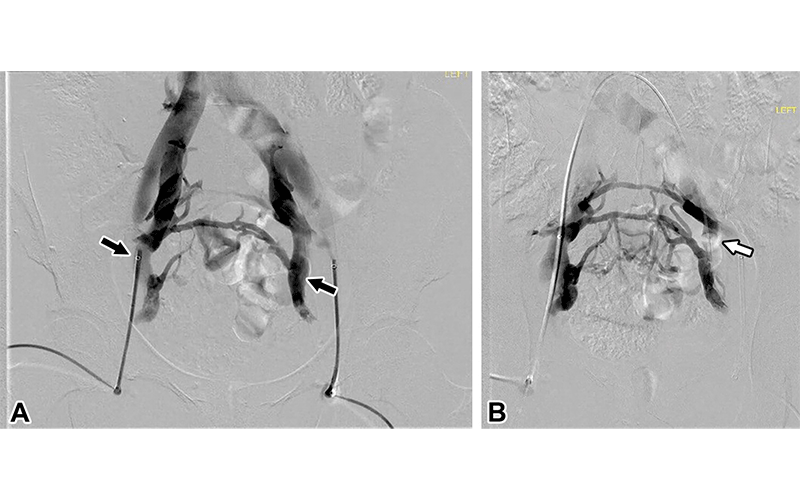Interventional Radiology's Role in Obstetrics and Gynecology
Treatments evolve to address multiple conditions that affect women

During Women's Health Month, RSNA News highlights the pivotal role radiology plays in support of women's health. This is the second of three stories. Read part one and part three.
Interventional radiologists are finding advances and new applications for procedures in women’s health.
“The role of IR has grown significantly in different areas of women’s health in the last decade, with focused research in gynecological diseases, particularly fibroids and adenomyosis management, with increased understanding of pelvic venous disease,” said Gloria Salazar, MD, clinical associate professor and vice chair of diversity and health equity in the Department of Radiology at University of North Carolina at Chapel Hill.
IR Can Help Improve Chronic Pelvic Pain
Pelvic venous disease (PeVD) is defined as the spectrum of symptoms and signs arising from the veins of the pelvis and their primary drainage pathways. PeVD remains poorly understood and frequently misdiagnosed in part because of the nonstandard terminology and limited diagnostic criteria for the venous conditions it encompasses.
The pathophysiology contributing to the patient’s symptoms will determine the best endovascular treatment for PeVD. These can include gonadal vein (GV) embolization, IV sclerotherapy and venous stent placement.
“The treatment of PeVD is nuanced and variable between patients, since numerous causes contribute to patient's symptoms, and different treatment options may be needed to achieve clinical success,” Dr. Salazar said. “Adding to this complexity is the fact that the presentation of the disease is variable in women of various ages, with the need for venous stent placement occurring more commonly in older patients."

Updates in UAE and IR
Uterine artery embolization (UAE) is the most studied for treatment of uterine fibroids and is also being researched as an alternative treatment for hysterectomy and myomectomy.
UAE for treatment of symptomatic fibroids consists of selectively catheterizing the uterine artery (UA) with subsequent delivery of permanent particles into the perifibroid plexus vasculature. Due to the permanent effect of the embolization, there is a noticeable reduction of fibroids’ size and associated symptoms. It is a minimally invasive alternative for women wishing to avoid hysterectomy.
“Research supports the fact that UAE is a great treatment option for patients experiencing heavy bleeding, bulk-related symptoms and other symptoms that affect the quality of life, such as fatigue and sexual dysfunction,” Dr. Salazar said. “Through thirty years of research, we can offer to the global interventional radiology community a non-surgical procedure that preserves the uterus instead of removing it, and we are currently researching this procedure to potentially assist patients with adenomyosis.”
Adenomyosis is abnormal location of endometrial tissue within the myometrium that is associated with hypertrophy or hyperplasia of the stromal tissue of the myometrium. Adenomyosis has shown positive treatment results with UAE.
While hysterectomy remains the definitive treatment, many patients are interested in uterine-sparing treatments when initial medical treatment is unsuccessful.
“Researchers are still debating the long-term effects of UAE in patients with fibroids who desire to become pregnant,” Dr. Salazar said. “To that end, we convened a Research Consensus Panel with
the SIR Foundation last year to start addressing these research gaps, and the results will be published in the upcoming months.”

“The role of IR has grown significantly in different areas ofwomen’s health in the last decade, with focused research ingynecological diseases, particularly fibroids and adenomyosis management, with increased understanding of pelvic venous disease.”
GLORIA SALAZAR, MD
IR and Obstetrics Options
Several interventional radiology techniques are available for obstetric patients with conditions associated with high-risk bleeding. UAE can be used for primary and secondary postpartum hemorrhage and in some instances may be performed in place of hysterectomy. UAE is also effective for patients with placenta accreta spectrum for planned cesarean hysterectomy.
Interventional options include the placement of occlusion balloons before surgery, embolization before surgery, and embolization after delivery but before surgery. Endovascular occlusion balloon placement has been shown to significantly reduce blood loss, transfusion requirements, intensive care unit admissions, and overall adverse events. Growing evidence is now demonstrating that UAE following cesarean delivery before hysterectomy decreases the risk associated with uncontrollable post-partum hemorrhage in these patients.
“Given the abundant data available for UAE compared to surgical alternatives, in 2024, we know exactly what to expect in terms of clinical outcomes and the benefits it offers to our patients," Dr. Salazar said. "However, the high-level of evidence has not translated into improved utilization of this procedure as an alternative to surgical options and as treatment for fibroids and post-partum hemorrhage, partly because of lack of awareness of this procedure by patients and other physicians."
Educating Patients About IR
All IR procedures related to women’s health can be performed as an outpatient procedure, according to Dr. Salazar, and under conscious sedation, depending on the patient's baseline health status. Most patients are not familiar with IR and therefore they do not have a full understanding of the minimally invasive options to treat their gynecological diseases, which has limited global adoption of UAE, according to Dr. Salazar.
“For example, UAE could help decrease maternal mortality, as a tool to treat post-partum-hemorrhage but patients are still not being referred to this procedure in the emergency-setting, even in the U.S.,” Dr. Salazar said. “Given the increased incidence of maternal mortality in the U.S. and in low- to mid-income countries, with resultant increase in peripartum hysterectomies, improved referral patterns and collaborations are required to improve access to these IR services.” 1, 2
For More Information
Access the RadioGraphics paper, “Interventional Radiology in Obstetrics and Gynecology: Updates in Women’s Health.”
Read previous RSNA News stories on imaging and women's health:
- Responsible Steps to Implementing AI in Breast Screening
- AI Performs Comparably to Human Readers of Mammograms
- Radiology Plays Vital Role in Detecting Intimate Partner Violence
Citations
1 Vargas-Riaño E, Becerril-Montekio V, Becerra-Posada F, Tristán M. Maternal health research outputs and gaps in Latin America: reflections from the mapping study. Globalization and Health. 2017 Sep 18;13(1):74. doi: 10.1186/s12992-017-0300-2. PMID: 28923096; PMCID: PMC5604511
2 Sobhy S, Arroyo-Manzano D, Murugesu N, et al. Maternal and perinatal mortality and complications associated with caesarean section in low and middle-income countries: a systematic review and meta-analysis of 12 million pregnancies. Lancet. 2019. https://doi.org/10.1016/S0140-6736(18)32386-9.